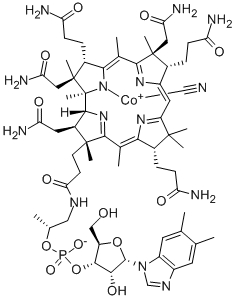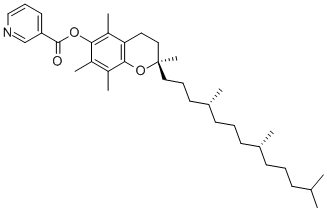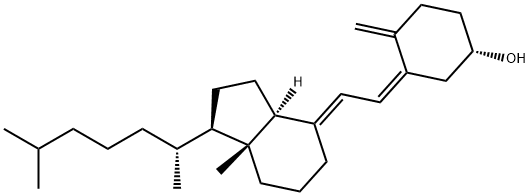ASCORBATE OXIDASE
Synonym(s):L -Ascorbate:oxygen oxidoreductase;Ascorbase;Ascorbate Oxidase, Cucurbita sp.
- CAS NO.:9029-44-1
- Empirical Formula: N/A
- Molecular Weight: 0
- MDL number: MFCD00130560
- EINECS: 232-852-6
- Update Date: 2024-11-19 23:02:33
What is ASCORBATE OXIDASE?
Chemical properties
Appearance : Light blue amorphous powder, lyophilized
Stability : Store at -20℃ (A decrease in activity of ca.20% may occur at 5℃ within 6 months.)
Molecular weight : 132,000, 140,000
Isoelectric point : between 6.0 and 7.8 , 8.2
Michaelis constant : 2.5×10-4M (Ascorbate)
Structure : 8 copper atoms per mol of enzyme
Inhibitors : cyanide, Na2S, diethyldithiocarbamate (Na)
Optimum pH : 5.6
Optimum temperature : approx. 30℃
pH Stability : pH 7.0-10.0 (25℃, 17hr)
Thermal stability : below 40℃ (pH 8.0, 30min)
Substrate specificity : This enzyme oxidizes ascorbic acid and several ascorbic derivatives.
The Uses of ASCORBATE OXIDASE
Ascorbate oxidase, from Cucurbita sp., may be used to study oxidative stress and heat stress response and tolerance. Also used in ascorbic acid assays to study the heat stress response of Arabidopsis and useful for enzymatic determination of ascorbic acid and for eliminating the interference of ascorbic acid in clinical analysis.
The Uses of ASCORBATE OXIDASE
Biochemical research.
Definition
An enzyme found in plant tissue that acts upon ascorbic acid in the presence of oxygen to produce dehydroascorbic acid.
General Description
Ascorbate oxidase is a homodimeric enzyme, which comprises 552 amino acid residues per subunit (zucchini). It corresponds to a molecular mass of 70kDa per subunit. This enzyme is mainly found in plants, fungi and eubacteria.
Biochem/physiol Actions
Ascorbate oxidase (AO) participates in cell growth by regulating reduction/oxidation (redox) of the apoplast. This enzyme can synthesize the oxidative molecule dehydroascorbate acid (DHA) in the apoplast. It is also involved in cell elongation and enlargement development.
Properties of ASCORBATE OXIDASE
| storage temp. | 2-8°C |
| solubility | Soluble in aqueous buffers. |
| form | powder |
| color | faintly bluish |
Safety information for ASCORBATE OXIDASE
| Signal word | Warning |
| Pictogram(s) |
 Exclamation Mark Irritant GHS07 |
| GHS Hazard Statements |
H315:Skin corrosion/irritation H319:Serious eye damage/eye irritation H335:Specific target organ toxicity, single exposure;Respiratory tract irritation |
| Precautionary Statement Codes |
P302+P352:IF ON SKIN: wash with plenty of soap and water. P305+P351+P338:IF IN EYES: Rinse cautiously with water for several minutes. Remove contact lenses, if present and easy to do. Continuerinsing. |
Computed Descriptors for ASCORBATE OXIDASE
New Products
(S)-3-Aminobutanenitrile hydrochloride 4-Methylphenylacetic acid N-Boc-D-alaninol N-BOC-D/L-ALANINOL Tert-butyl bis(2-chloroethyl)carbamate 3-Morpholino-1-(4-nitrophenyl)-5,6-dihydropyridin- 2(1H)-one Furan-2,5-Dicarboxylic Acid Tropic acid S-2-CHLORO PROPIONIC ACID ETHYL ISOCYANOACETATE 2-Bromo-1,3-Bis(Dimethylamino)Trimethinium Hexafluorophosphate 4-IODO BENZOIC ACID 3-NITRO-2-METHYL ANILINE 1-(2,4-DICHLOROPHENYL) ETHANAMINE (2-Hydroxyphenyl)acetonitrile 4-Bromopyrazole 5,6-Dimethoxyindanone 2-(Cyanocyclohexyl)acetic acid 4-methoxy-3,5-dinitropyridine 1-(4-(aminomethyl)benzyl)urea hydrochloride 2-aminopropyl benzoate hydrochloride diethyl 2-(2-((tertbutoxycarbonyl)amino) ethyl)malonate tert-butyl 4- (ureidomethyl)benzylcarbamate Ethyl-2-chloro((4-methoxyphenyl)hydrazono)acetateRelated products of tetrahydrofuran








You may like
-
 Ascorbate oxidase CAS 9029-44-1View Details
Ascorbate oxidase CAS 9029-44-1View Details
9029-44-1 -
 L-Ascorbate Oxidase (Type 2) ex. Acremonium Sp. CAS 9029-44-1View Details
L-Ascorbate Oxidase (Type 2) ex. Acremonium Sp. CAS 9029-44-1View Details
9029-44-1 -
 L-Ascorbate Oxidase (Type 1) ex. Cucurbita Sp. CAS 9029-44-1View Details
L-Ascorbate Oxidase (Type 1) ex. Cucurbita Sp. CAS 9029-44-1View Details
9029-44-1 -
 Ascorbate Oxidase from Cucurbita sp. CAS 9029-44-1View Details
Ascorbate Oxidase from Cucurbita sp. CAS 9029-44-1View Details
9029-44-1 -
 Ascorbate Oxidase, Cucurbita sp. CAS 9029-44-1View Details
Ascorbate Oxidase, Cucurbita sp. CAS 9029-44-1View Details
9029-44-1 -
 1975-50-4 98%View Details
1975-50-4 98%View Details
1975-50-4 -
 14714-50-2 (2-Hydroxyphenyl)acetonitrile 98+View Details
14714-50-2 (2-Hydroxyphenyl)acetonitrile 98+View Details
14714-50-2 -
 118753-70-1 98+View Details
118753-70-1 98+View Details
118753-70-1